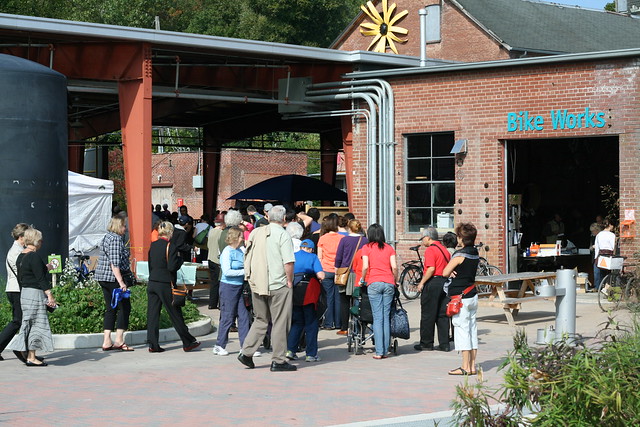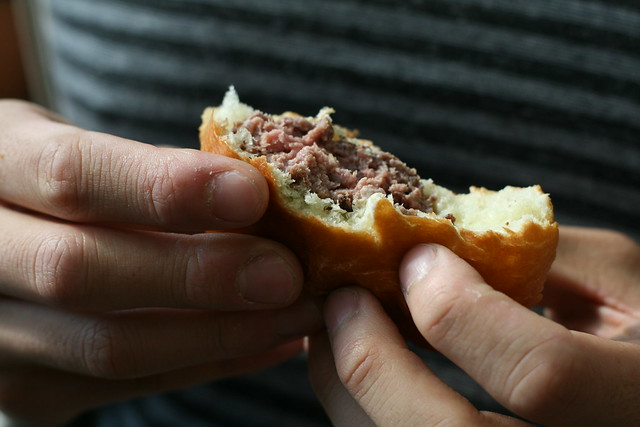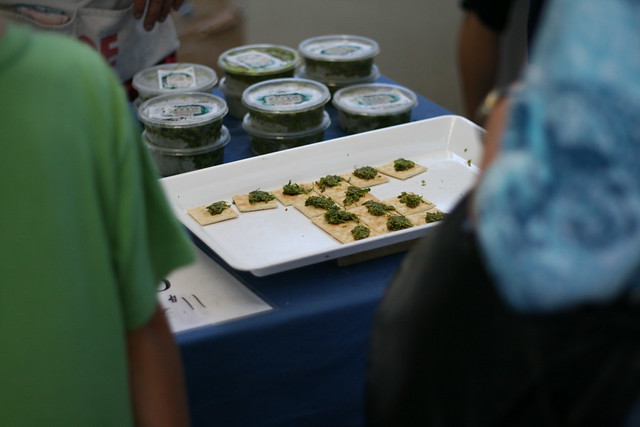 Recently the Beehive was granted the exciting privilege of a private visit to the Art Gallery of Hamilton’s exhibition Quilts! A Gift from Carole and Howard Tanenbaum to the Textile Museum of Canada. As pretty much all of us are textile superfans, we gazed with reverence at the 17 quits on display, marveling at the textures, colours and skilled handwork at play in these Canadian, American and British works dating back to the 1830s.
Recently the Beehive was granted the exciting privilege of a private visit to the Art Gallery of Hamilton’s exhibition Quilts! A Gift from Carole and Howard Tanenbaum to the Textile Museum of Canada. As pretty much all of us are textile superfans, we gazed with reverence at the 17 quits on display, marveling at the textures, colours and skilled handwork at play in these Canadian, American and British works dating back to the 1830s.
 Though many of their makers are unknown (and were certainly not releasing artist statements!) , the quilts in their distinctiveness inspired us to try to imagine the thought process involved in creating them. Pieced Quilt (1880) for example appears to have no rhyme or reason in the colour placement - the maker seemingly having worked their way through their scrap pile, moving on to one fabric as they ran out of the last. Randomness in this and other quilts through the interruption of pattern (or lack thereof) has very personal and charming effect. Equally charming are the backs of the quilts, which we attempted to sneak peeks at wherever we could and oohed and ahhed at the boro-like patchwork or sweetness of a simple cotton paisley.
Though many of their makers are unknown (and were certainly not releasing artist statements!) , the quilts in their distinctiveness inspired us to try to imagine the thought process involved in creating them. Pieced Quilt (1880) for example appears to have no rhyme or reason in the colour placement - the maker seemingly having worked their way through their scrap pile, moving on to one fabric as they ran out of the last. Randomness in this and other quilts through the interruption of pattern (or lack thereof) has very personal and charming effect. Equally charming are the backs of the quilts, which we attempted to sneak peeks at wherever we could and oohed and ahhed at the boro-like patchwork or sweetness of a simple cotton paisley.
 Some quilts appear to have been made with a more distinct vision, or boast luxury fabrics such as brocades, printed silks, and patterned velvets. Pieced Quilt with Sawtooth Stars and Diamonds Pattern (1836) is a particularly stunning example of a quilt made with naturally dyed silk (prior to the invention of synthetic dyes 20 years later) and has maintained a rich colour palette of purples, maroons, greens and reds. The crazy quilts - irregular patchwork quilts joined through decorative embroidered borders - incorporate many different luxury fabrics as well pieces of cultural history such as Crazy Quilt in 30 Blocks (1885) which includes a ribbon showing the "Great Bridge - length 5989 feet" aka the Brooklyn Bridge which was completed in 1883.
Some quilts appear to have been made with a more distinct vision, or boast luxury fabrics such as brocades, printed silks, and patterned velvets. Pieced Quilt with Sawtooth Stars and Diamonds Pattern (1836) is a particularly stunning example of a quilt made with naturally dyed silk (prior to the invention of synthetic dyes 20 years later) and has maintained a rich colour palette of purples, maroons, greens and reds. The crazy quilts - irregular patchwork quilts joined through decorative embroidered borders - incorporate many different luxury fabrics as well pieces of cultural history such as Crazy Quilt in 30 Blocks (1885) which includes a ribbon showing the "Great Bridge - length 5989 feet" aka the Brooklyn Bridge which was completed in 1883.

 As the quilts range from having been completed in the 1830s to the 1950s, there is some textile history to be learned in this exhibit as well. While earlier English quilts tended to start with a central medallion then finish with a distinctive border (much like an oriental carpet, as seen in Framed-medallion Quilt (1850)), by the second half of the 19th century, quilters began to structure them as a series of blocks arranged in a grid - making them easier to sew as smaller blocks could be made individually and joined later. This style of quilting is much more common today than the more labour intensive method of assembling the quilt from the centre outward. The topic of labour and time came up frequently amongst us Bees as we tried to imagine how many hours must have been invested and wondered how the makers found the time. In our current age of the instant the amount of time invested in the more complex quilts is almost unfathomable and something to be admired.
As the quilts range from having been completed in the 1830s to the 1950s, there is some textile history to be learned in this exhibit as well. While earlier English quilts tended to start with a central medallion then finish with a distinctive border (much like an oriental carpet, as seen in Framed-medallion Quilt (1850)), by the second half of the 19th century, quilters began to structure them as a series of blocks arranged in a grid - making them easier to sew as smaller blocks could be made individually and joined later. This style of quilting is much more common today than the more labour intensive method of assembling the quilt from the centre outward. The topic of labour and time came up frequently amongst us Bees as we tried to imagine how many hours must have been invested and wondered how the makers found the time. In our current age of the instant the amount of time invested in the more complex quilts is almost unfathomable and something to be admired.
 Though originally intentioned as functional pieces, the Tanenbaums (skilled art collectors) were clearly drawn to these quilts based on their aesthetic impact and artistry. In placing them on the gallery walls, we are asked to re-examine our relationship to these domestic objects that are so frequently lumped in with the curtains or the welcome mat - to consider them as works of art. These are not simply quilts, they are Quilts!
Though originally intentioned as functional pieces, the Tanenbaums (skilled art collectors) were clearly drawn to these quilts based on their aesthetic impact and artistry. In placing them on the gallery walls, we are asked to re-examine our relationship to these domestic objects that are so frequently lumped in with the curtains or the welcome mat - to consider them as works of art. These are not simply quilts, they are Quilts! 
Quilts! A Gift from Carole and Howard Tanenbaum to the Textile Museum of Canada
On view until January 15, 2012
Art Gallery of Hamilton
123 King Street West | Hamilton ON | L8P 4S8
T: 905-527-6610
E: info@artgalleryofhamilton.com
artgalleryofhamilton.com
Photos by Hollie



















































